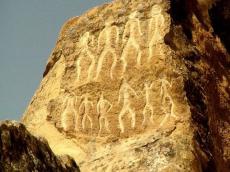|
|
TODAY.AZ / Arts & Entertainment
Gobustan rock art: cradle of civilization and fine art
24 August 2022 [17:45] - TODAY.AZ

By Azernews
By Vugar Khalilov
Rock drawings (rock art) are unique sources of information about the prehistoric life of humanity. They attract historians, archaeologists, art historians, ethnographers, linguists, folklorists, zoologists, and other scientists. These monuments have been unearthed almost everywhere on Earth, with over 35 million petroglyphs recorded in 120 countries.
Azerbaijan holds a unique position as one of the world's ancient centers of civilization. Evidence of human race development throughout history may be found here.
The history of rock art in Azerbaijan is extensive and spans several epochs, including the Upper Paleolithic, Mesolithic, Neolithic, Eneolithic, Bronze Age, and the Middle Ages. The geography of petroglyphs in Azerbaijan is very extensive: they may be found almost anywhere in the country.
Gobustan is home to Azerbaijan's most famous and well-studied rock art. Evidence of people's lives in the Stone Age and subsequent times was discovered in the Gobustan Mountains.
The Gobustan rock drawings were found in the 1930s. At the time, there was activity in the nearby stone quarry, and the area was piled high with enormous stone rocks. As the area cleared, the images became more noticeable. Many artworks were also unearthed in the caverns nearby.
Archaeologists uncovered over 7,000 drawings on over 1,000 rocks in 1939, along with ancient settlements, caves, 40 burial mounds (a tumulus), and over 100,000 material culture artifacts. The majority of the ancient artifacts dating from the Mesolithic period. However, life is thought to have existed here earlier, giving cause to consider Gobustan to be one of the cradles of civilization.
The Gobustan petroglyphs date back to the XV–VIII millennia BC (or XV–X millennia according to some other experts), as well as some part of them to the Middle Ages. They are among the unique rock collections in the world since they span such a broad time period.
The drawings' diverse topics, styles, layouts, and execution techniques, as well as the fact that they were portrayed on top of one other from ancient to modern times, indicate the stages of evolution of Gobustan's petroglyphs. Human life is typically the theme of these works of art.
Hunting scenes on horseback and on foot, battle scenes, scenes of collective labor, and harvest scenes have been discovered on this historical site. Drawings depicting solo and group ceremonial dances resembling Azerbaijan's current "Yalli" folk dance have been preserved on the rocks.
During the time when some of these drawings were created, Gobustan most likely had a tropical climate and diverse flora and wildlife. Drawings of creatures that lived here during the previous 10,000 years may be seen, including gazelles, wild goats, deer, boars, horses, and lions, as well as birds, fish, snakes, lizards, and other insects.
Gobustan drawings are known for dividing human images into masculine and female silhouettes. The nearly life-size human silhouette drawings are supposed to be older, dating back to the Early Neolithic Age when matriarchy governed tribe life and mothers were revered as tribe leaders.
In addition to human silhouettes, there are life-size outline drawings of wild bulls, some of which are 240 centimeters long and 140 centimeters high. Large and somewhat reduced contour drawings of wild bulls, as well as miniature depictions of humans armed with arrows, date back to the VII-IV millennia BC when hunting was a major part of people's subsistence.
Drawing styles have evolved throughout time. They began to reduce in size throughout the Bronze Age, in contrast to earlier ones, which were typically life-size. The use of more modern tools, such as metal tools, aided in the development of fine arts.
Due to the decline in the economic importance of hunting and the emergence of fine art on pottery and metal in the Middle Ages (from the 8th century onward), Gobustan's rock drawings became schematic and their sizes steadily diminished.
The cultural landscape of Gobustan rock art was added to the list of UNESCO World Heritage sites in 2007, taking into consideration the importance of the reserve for the entire world.
URL: http://www.today.az/news/entertainment/224550.html
 Print version
Print version
Connect with us. Get latest news and updates.
See Also
- 24 April 2025 [13:14]
Lecture on Mirza Kadim Irevani's legacy delivered in Kyrgyzstan - 24 April 2025 [12:19]
Book by national writer presented in Kyrgyzstan - 23 April 2025 [14:51]
Gala State Reserve marks its 37th anniversary with tree planting campaign - 23 April 2025 [11:43]
State Philharmonic Hall pays tribute to eminent composer - 22 April 2025 [14:15]
Int'l Jazz Day in Baku to celebrate freedom and inspiration - 22 April 2025 [13:11]
Baku, Tashkent to hold joint art projects - 22 April 2025 [11:05]
Leyla Aliyeva meets with spouse of Secretary General of Central Committee of Vietnam's Communist Party - 22 April 2025 [10:41]
Culture Minister meets with Kyrgyz counterpart in Bishkek - 21 April 2025 [15:38]
Festival in Masalli embraces arts and fosters creative expression - 21 April 2025 [14:33]
Film about Garabagh War premiered in Nizami Cinema Center
Most Popular
 Culture Minister meets with Kyrgyz counterpart in Bishkek
Culture Minister meets with Kyrgyz counterpart in Bishkek
 Trump sees hope for Ukraine-Russia deal, analysts remain skeptical
Trump sees hope for Ukraine-Russia deal, analysts remain skeptical
 Azerbaijan's Chamber of Accounts urges strengthening audits on renewables & green budgeting
Azerbaijan's Chamber of Accounts urges strengthening audits on renewables & green budgeting
 Azerbaijan and China sign mutual visa exemption agreement for ordinary passport holders
Azerbaijan and China sign mutual visa exemption agreement for ordinary passport holders
 Oil exports from Azerbaijan to Tabriz may be on agenda during Pezeshkian's visit to Baku
Oil exports from Azerbaijan to Tabriz may be on agenda during Pezeshkian's visit to Baku
 Leyla Aliyeva meets with Vice-President of Vietnam to expand humanitarian and cultural ties
Leyla Aliyeva meets with Vice-President of Vietnam to expand humanitarian and cultural ties
 South Korea launch fourth reconnaissance satellite into orbit
South Korea launch fourth reconnaissance satellite into orbit
